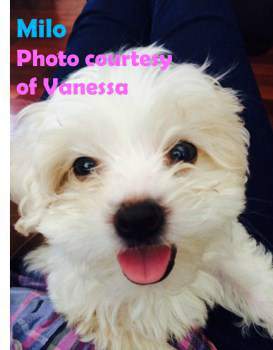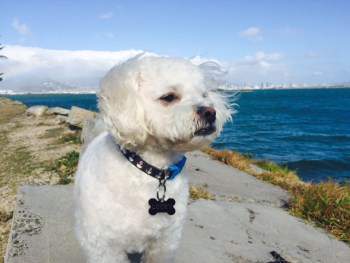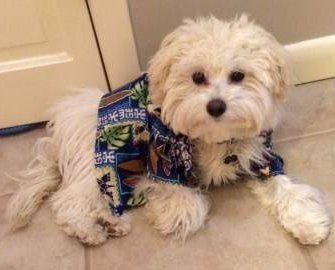Answering Your Questions About Why Maltipoos Do Things

Here are the Top 10 Questions that We Receive
Please note: PetMaltipoo is reader-supported. Some of the product suggestions on this page are affiliate links. As an Amazon Associate we earn from qualifying purchases. This is at no extra cost to you and helps us continue creating useful content.
Q1: Why are Maltipoos So Hyper?
As with many behavioral questions, we must first look to the Toy Poodle and the Maltese. Both are toy breed dogs, which in and of itself, lends to a rather active, expressive canine. Long ago, when breeds were being developed, the trait of patience was inbred to certain breeds (quiet hunters that waited tolerantly for its prey). With others, calm awareness along with aggressive temperament should it be needed, was a desired trait (watch dogs). With small, toy breeds, the goal was to create an affectionate, active and animated pet that would be an inside companion. Certainly, being unobtrusive and introverted were not traits that were instilled as it would not lend to the goal of a lap dog, companion.
With this being said, while it is not normal for adult Maltipoo dogs to be bouncing off of the walls, the reason that many Maltipoos are hyper
and have high energy levels is because this is not the type of dog that rests quietly in the corner, unseen or unheard.
Puppies, in general, are very hyper. The first year is one of great discovery! Every new object (and even some that are familiar) are seen as treasures. What is this? Can I chew it? What happens if I pounce on this? Puppies also are learning what is right and wrong, not purposely testing their human parents, but rather exploring, discovering and letting loose, so to speak and it is up to the owner to set limits, showing a puppy what is acceptable and what is not.
As a Maltipoo matures from puppy to adult, there will be a steady decrease in hyperactivity. The dog learns the rules of the household, and learns which behaviors lead to reward and which lead to being ignored.
One of the best methods of dealing with a very hyper Maltipoo puppy is to ensure that he is receiving enough exercise
that will allow him to release pent up energy. Once all puppy shots are given, 2 walks per day (20 minutes or so) can make a huge difference in behavior levels displayed at home.
Q2: Why Are Maltipoos So Expensive?
The price of Maltipoos varies quite a bit and this is dependent on many factors. There are first generation Maltipoos (the result of a purebred Maltese being paired with a purebred toy Poodle) and 2nd generation (Maltipoo to Maltipoo). In general, you can expect higher prices with 1st generation dogs. As opposed to how breeders of recognized purebreds can keep a couple of puppies from a litter to use in their breeding
practice in the future, this cannot happen with 1st generations. Therefore, a Maltipoo may be much more expensive.
In addition, the fewer breeders that there are, the less quantity of Maltipoo dogs are available and this can keep the price high. If quality Maltipoos were available around every corner and each state, providence and region had a huge amount of breeders that were offering high quality, healthy Maltipoo puppies, it would certainly drive prices down and they would not be so expensive.
With this said, you need not spend thousands of dollars for a crossbreed. It is best to take your time, locate 3 or 4 breeders and have patience if you are put on a waiting list for an upcoming litter. Check pricing in your area and even if you have wanted a Maltipoo forever, do not pay exorbitant prices that seem unfair.
Q3: Why are Maltipoos so Yappy?
We can look to the answer for being hyper on this one, remembering that the Maltipoo - by nature - is not an overly reserved, quite dog. However, on the flip side, it is quite an exaggeration to say that all toy sized dogs are yappy. Some will be more vocal than others, however with proper training and enough attention given to a canine family member, a Maltipoo will not yap and bark all day.
For many, yapping is a form of communication and may simply mean "I need to go to the bathroom" or it may be a dog's way of letting you know that he has been pent up for too long inside the home and a walk is needed.
For other Maltipoos that become yappy, this is often due to being left home alone or when home with owners, boredom sets in. While you cannot be with your puppy or dog every second, potential owners should not obtain a puppy or dog unless they have given careful thoughts as to whether or not they have the time to devote to a pet. Dogs need walks, grooming, command training, house training
and bonding time. They need interactive toys
that will hold their interest and offer mental stimulation.
Importantly, socialization training (being exposed to other dogs, to situations and to people) is needed so that what may normally trigger a Maltipoo to become yappy no longer does.
Q4: Are Maltipoos a Good Dog?
This answer is dependent on the lifestyle and expectations of the owner. Obviously, if you are looking for a watchdog, the answer is 'probably not'. However, the Maltipoo has many great qualities that make him a great family pet.
What makes the Maltipoo a good dog to own? He is light shedder (has hair opposed to fur), he is affectionate, enjoys the company of humans, is the right size for just about any home or apartment and has low to moderate grooming requirements. The temperament of this breed is happy, alert, intelligent, loyal, fun-loving and easy going. Maltipoos do well as both a 'single-pet' and in a house with other dogs or even a cat.
If you are thinking about bringing a Maltipoo into your home, we encourage you to have a look around to learn more about behaviors, grooming, feeding
and more.

Lucky Master, 3 years old
Photo courtesy of Rus Pascual, (Honolulu, Hawaii)
Q5: Why Do Maltipoos Get Tear Stains?
There are actually a few different reasons why tear staining occurs. First, while there are some darker Maltipoos, many hold a lighter coat (due to the pure white Maltese sire or dam) and tear staining will be much more obvious on a light colored coat.
Both Maltese and Toy Poodles can have tear staining and therefore, the Maltipoo as well.
While most owners know to give baths about 1 time every 3 weeks, the eye area needs to be cleaned on a daily basis. Food particles, debris and so forth quickly accumulate on the face - as well as eye discharge that slowly ebbs from the tear ducts - and this means that wiping the eye area and face after every meal or at least once per day will greatly help keep that area clean.
Another element that can lend to a Maltipoo having problems with getting tear stains is the high mineral content that is often found in tap water. In fact, many people would be absolutely shocked to learn what is actually in their tap water. While rules vary from city to city, there are many town water supplies that are legally allowed to contain low levels of pesticides and factory runoff. What can you do? Obtaining a filter for your kitchen tap can make a huge difference. Even elements such as plastic bowls can cause hairs to become stained… Learn more in the Tear Staining
section.
Q6: Why do Maltipoos Lick so Much?
This is a great question, because while each dog is very different, some will lick so much that it can become a huge problem. In regard to a Maltipoo licking his owner, this is due to 2 things: Attempting to gain attention and the flavor of salt that a dog tastes when licking skin.
In regard to a Maltipoo licking himself, this is a completely different issue. Licking the body is most often due to trying to relieve some sort of discomfort. And most times that discomfort is itching. What can cause a Maltipoo to feel itchy? This can range from an allergy
(food, contact allergy to carpeting, bedding, etc.) to a skin yeast infection to skin mites.
Some dogs can lick so much that bald spots start to appear and skin becomes raw and red. If there is excessive licking along with hair loss, red irritated skin or rash or if excessive licking of the body lasts for more than a few days, it is prudent to bring your Maltipoo for a veterinarian checkup.
With this said, a Maltipoo licking may be a formed habit that may be resolved with distraction and access to a wide range of interesting toys. In addition, licking may be a nervous habit, often done when the dog is left home alone or is feeling vulnerable in new situations. It can even develop in high noise level households in which the dog is unable to relax.
Q7: Why Does My Maltipoo Shed?
Since many owners are told that this crossbred does not shed, many people can become very worried and confused when shedding does occur. The Maltipoo is not a heavy shedder as are some other breeds - particularly those with thick, double coats of fur. However, there is no such thing as a dog that does not shed at all (save for the Chinese Crested and 4 other breeds which essentially do not have a coat).
While the Maltipoo does have hair and not fur, Maltipoos will shed since each hair on the coat goes through a cycle: Growth, rest and release, just like human hair. Each strand of hair is on its own point in this cycle, which means that at any given time some strands are falling out and some are growing in.
Therefore, in the sense of the coat gradually renewing itself, yes, the Maltipoo does shed. Routinely and regularly brushing the coat will not only keep it clean, it keeps the skin healthy and will decrease the amount of shedded hairs that you find.
Keeping all of that in mind, heavy shedding is not normal and may be due to a wide range of factors including skin infection, an impaired immune system or other health condition. Even severe allergies can cause an alarming loss of coat. If the coat is thinning out, if you see any bald patches or any other signs of abnormal hair loss, do bring your Maltipoo to the veterinarian for a complete check-up.
Q8: Why Does My Maltipoo Growl at Me?
While barking and yapping are normal vocalizations for dogs, growling is not considered an acceptable 'normal' vocalization and does point to there being an issue.
First, it should be noted that when a dog is feeling ill or is suffering from an injury, canine instinct kicks in, making that dog feel vulnerable even in the presence of his loving owners. It is not uncommon for a dog in pain to snap at or growl at his owners. In this case, it would happen when the Maltipoo is being touched, picked up or manipulated in a way that causes additional pain or if the area of concern is being touched or pressure is being put on it.
Luxating patella
(the kneecap slips out of place) or hip dysplasia
(dislocation of the hip joint and socket) are 2 common health conditions that may not outwardly show but do cause enough discomfort that a dog growls when touched.
Another issue that may cause a Maltipoo to growl is a very out of balance hierarchy in the household. Dogs that mistakenly believe (or are inadvertently taught to believe) that they are the Alpha of the house may growl at their humans. Growling may be a form of aggression, but it is also a show of dominance. Whether the Maltipoo growls to say "get away from me' or growls to say 'This food is MINE', owners should take immediate steps to re-train a dog the Alpha/Beta order. A notable exception would be when a young child is involved. If your Maltipoo is growling at a young child
in the household, since a bite can follow this verbal warning, we would then recommend contacting a professional dog trainer that can come to your home for one-on-one sessions.
While you of course love your dog and want him/her to be your companion and best friend, someone must be the Leader of the Pack…and if it is not you (and other humans in the house) it will be the dog, which will lead to all sorts of negative behavior, including growling.
A few things that you can do to resolve this - and be sure that every human in the house is on the same page- is to follow these rules:
Humans eat first. Any time that you and your Maltipoo are eating at the same time, your puppy or dog should see that you sit down and begin eating first. Once the dog is aware of that, the next step is to command the puppy or dog to sit, staying firm that no food will be given until the command is obeyed. Once that is done, the dog's bowl is placed down. Using the command to sit before placing food should be done for all meals and snacks, regardless of whether you are dining at the same time or not.
Humans enter and exit the house first. While it may seem easier for your Maltipoo to lead the way, this can send a very strong message to a dog and not the message that you want. For dogs that are challenging the hierarchy in the house by growling, allowing a dog to exit and enter first is akin to saying to the dog, 'You are the Leader, and therefore you are allowed to enter/exit the den before me'. It only reestablishes a dog's perceived reasoning that he is in charge.
Q9: Why Does My Maltipoo Shiver?
This is a good question because for many, there will need to be changes for the sake of the Maltipoo. Some mistakenly believe that shivering is normal and it most certainly is not.
1-
In regard to puppies, controlled shivering and trembling can point to hypoglycemia, which is a rapid drop in blood sugar levels and is not all that uncommon with puppies under the age of 4 months. This can be a very dangerous health condition
and in severe cases, it can lead to coma and death. Other signs are weakness, dizziness and confusion. This is treated by rubbing a dab of honey into the puppies gums (For fast release into the bloodstream) followed by an emergency visit to the closest vet or animal hospital, where IV fluids will be given to even out blood sugar levels.
2-
Maltipoo puppies may shiver due to being afraid and adults may do this as well, if they have not been socialized to certain elements. Allowing a dog to shiver in fear will not teach him to tolerate the trigger; removing the dog from the situation (even if that means telling people to stop petting him) and then following step-by-step guidelines for proper socialization will do the trick and allow a dog to become self-confident and self-assured. For a great book on this, you may wish to check out the highly rated book (Written by Faye Dunningham and available from Amazon in both Kindle and Hard Copy): The Well Socialized Dog: Step-by-Step Socialization Training for Puppies and Dogs
or our PetMaltipoo eBook
that covers this issue in detail.

Athos (Greek for gargantuan one), 10 months old
Photo courtesy of Anna Liechty (Plymouth, Indiana)
3-
Maltipoos of all ages are susceptible to feeling cold, even if you feel that the temperature is perfectly fine. You and your dog have completely different metabolisms and mechanisms for regulating body temperature. Adding to this, cold tolerance is dependent on percentage of body fat, amount of sleep and even how much food is in the body at any given point. If health issues and nervousness are ruled out, this may just be a matter of putting a cozy sweater on your Maltipoo to stop shivering or if it is viable, raising the temperature in the house a couple of degrees. If you are looking for really cute clothes for your Maltipoo, you may want to check out the Maltipoo Supplies
page.
4-
Shivering can also occur if a puppy or dog becomes excited. A puppy may become excited over elements that seem like to big deal to you, but if it is something new to him, a rush of adrenaline may occur. Additionally, Maltipoo dogs of any age may become extremely excited when their owner comes home after a long day away at work. In these cases, the shivering only lasts for a minute or so and is generally no cause for concern.
Q10: Why Does My Maltipoo Sleep so Much?
Dogs, in general, sleep more than humans. Including naps, the average time of sleep for an adult Maltipoo in a 24 hour period is 14 hours. Puppies tend to sleep more than this and seniors may take additional naps, putting the total amount of sleep up toward 16 or even 18 hours in those age groups.
Dogs that are bored will tend to sleep
much more, however some will develop destructive habits therefore boredom should be dealt with. Spending time with your Maltipoo is the best method of giving your dog a fulfilled, happy and interesting life. Go for walks in new places, take time to teach commands, explore together and bring your Maltipoo with you to places that allow dogs.
When leaving your Maltipoo home alone, he may sleep more than when you are home, however it is best to leave on a radio or TV and plenty of fun, interesting toys. Many dogs do well when having a window view, although this should be tested as for some, it can encourage barking.
Remember that it is normal for your Maltipoo to sleep so much more than you, however do take note of any red flags such as difficulty rousing awake, dizziness and/or confusion (walking into walls, unsteady gait) as these are signs medical conditions that need to be professionally treated right away.
Things To Do Now
Become a Free Member- (If you are not already a Member) so that you'll receive a friendly reminder we add new pages of information to this site. You can also suggest a topic for us to write about or ask a question about your Maltipoo.
Request your copy of the PetMaltipoo eBook - The most comprehensive Maltipoo book that exists. This is a "must-have" book for all Maltipoo owners.


